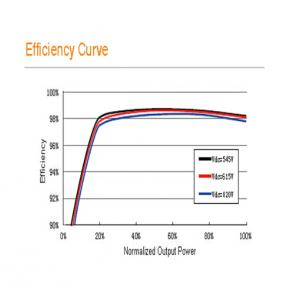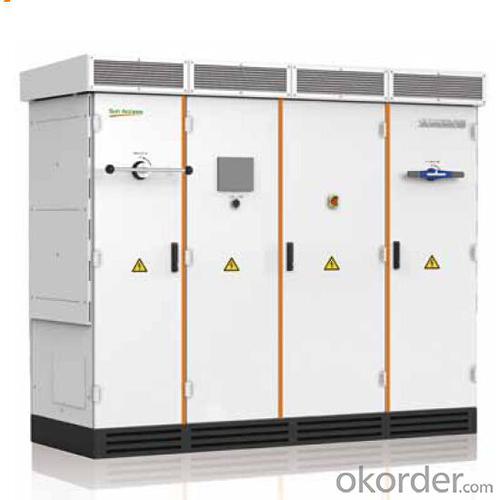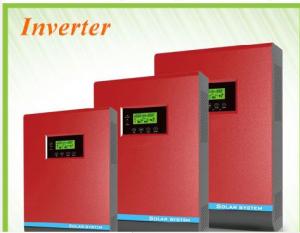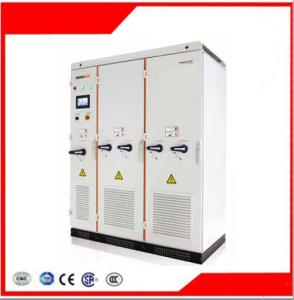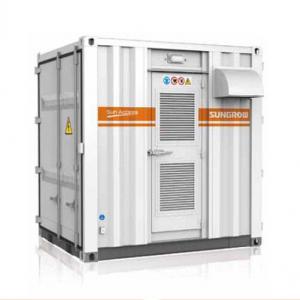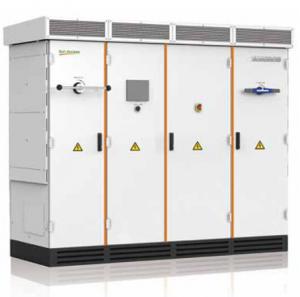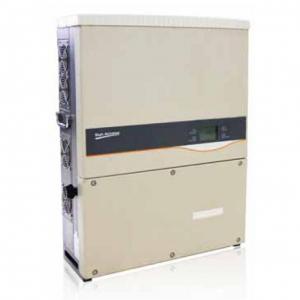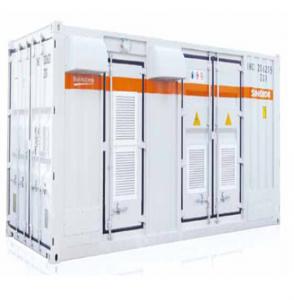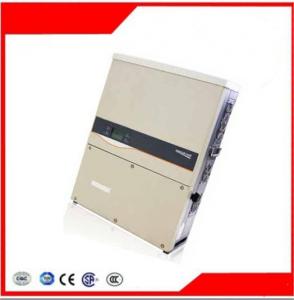Photovoltaic Grid-Connected Inverter SG750MX
- Loading Port:
- China Main Port
- Payment Terms:
- TT or LC
- Min Order Qty:
- 50 unit
- Supply Capability:
- 1000 unit/month
OKorder Service Pledge
OKorder Financial Service
You Might Also Like
1. Structure of Photovoltaic Grid-Connected Inverter SG750MX Description
A solar inverter, or PV inverter, or Solar converter, converts the variable direct current (DC) output of a photovoltaic (PV) solar panel into
autility frequency alternating current (AC) that can be fed into a commercial electrical grid or used by a local, off-grid electrical network.
It is acritical BOS–component in a photovoltaic system, allowing the use of ordinary AC-powered equipment. Solar inverters have
special functions adapted for use with photovoltaic arrays, including maximum power point tracking and anti-islanding protection.
Suitable for 50Hz/60Hz grid, could be used in Asia, North America and Europe.
2. Main Features of the Photovoltaic Grid-Connected Inverter SG750MX
• Transformerless inverter, max. efficiency of 98.7%, CEC efficiency of 98.5% for SG800MX,max. efficiency of 98.6%, CEC efficiency of 98.0% for SG750MX
• Employing a patented thermal management system, the inverter is able to operate from -13˚F to 140˚F (-25˚C to 60˚C), and up to 19,600’ (6,000 m).
• High power density, small equipment footprint
• DC disconnect, AC circuit breaker, separate DC & AC cabinets
• Max. DC input voltage is 1000V, can be mounted on a skid or an e-house, giving maximum design flexibility and lowering installation costs
• Continuous active power control
• Advanced grid support functionality, meet grid requirements around the world
• Full remote and local power curtailment, PF, HVRT, LVRT, FRT controls via ModBus & Ethernet
• Designed for 20+ years of operating life
• NEMA4X electronics cabinet
3. Photovoltaic Grid-Connected Inverter SG750MX Images

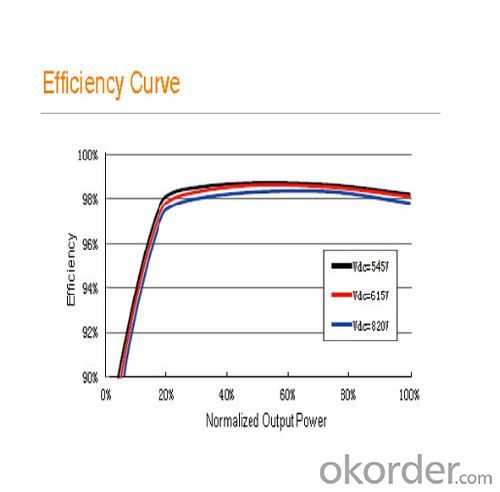
4. Photovoltaic Grid-Connected Inverter SG750MX Specification
Input Side Data |
|
Max. PV input power | 850kW |
Max. PV input voltage | 1000V |
Start voltage | 520V |
Min. operation voltage | 500V |
Max. PV input current | 1600A |
MPP voltage range | 500~820V |
No. of DC inputs | 1, 6-12 |
PV array configuration | Negative ground (standard), Floating or Positive Ground (optional) |
Output Side Data |
|
Nominal AC output power | 750kW |
Max. AC output apparent power | 825kVA |
Max. AC output current | 1512A |
THD | <3% (nominal power) |
Nominal AC voltage | 315V |
AC voltage range | 277~347Vac |
Nominal grid frequency | 50/60Hz |
Grid frequency range | 47~52Hz/57~63Hz |
Power factor | >0.99@default value at nominal power, adj. 0.8 overexcited~0.8 underexcited |
Isolated transformer | No |
DC current injection | <0.5 % In |
Efficiency |
|
Max. efficiency | 98.60% |
European efficiency | 98.30% |
CEC efficiency | 98.00% |
Protection |
|
Input side disconnection device | DC load switch |
Output side disconnection device | Breaker |
DC overvoltage protection | Yes |
AC overvoltage protection | Yes |
Grid monitoring | Yes |
Ground fault monitoring | Optional |
Over temperature protection | Yes |
Insulation monitoring | Optional |
General Data |
|
Dimensions(W×H×D) | 2598x2164x1000mm |
Weight | 2340kg |
Operating ambient temperature range | -25~+60℃(>55℃ derating) |
Noise emission | <70dB |
Night power consumption | <100W |
External auxiliary supply voltage | 480/600V(3/N/PE) |
Cooling method | Temperature controlled air-cooling |
Ingress protection rating | NEMA 3R(IP54) |
Allowable relative humidity range | 0~95% no condensing |
Max. operating altitude | 6000m (>3000m derating) |
Fresh air consumption | 4425 m³/h |
Display | LCD |
Communication | RS485/Modbus, Ethernet(Opt.) |
5. FAQ of Photovoltaic Grid-Connected Inverter SG750MX
Q1. What is the difference between inverter and solar inverter?
A1. Inverter only has AC inpput, but solar inverter both connect to AC input and solar panel, it saves more power.
Q2. What is the difference between MPPT&PWM?
A2. MPPT has higher efficiency, it can track the max power point and won't waste energy.
- Q: Can a solar inverter be used with a solar car charging system?
- Yes, a solar inverter can be used with a solar car charging system. The solar inverter is responsible for converting the direct current (DC) produced by the solar panels into alternating current (AC) that can be used to charge the car's batteries. By using a solar inverter, the solar car charging system can efficiently utilize the energy generated by the solar panels to power electric vehicles.
- Q: What is the role of a grid connection feature in a solar inverter?
- The role of a grid connection feature in a solar inverter is to facilitate the transfer of electricity between the solar panels and the electrical grid. It allows for the seamless integration of solar power into the existing electrical infrastructure, enabling excess electricity generated by the solar panels to be fed back into the grid, and drawing power from the grid when the solar panels are not producing enough electricity. This grid connection feature also ensures that the solar system meets the safety and regulatory requirements of the local electrical grid.
- Q: Can a solar inverter be used in countries with different electrical standards?
- Yes, a solar inverter can be used in countries with different electrical standards. However, it may require certain modifications or additional equipment to ensure compatibility with the specific electrical standards of that country.
- Q: What is the role of a frequency regulation feature in a solar inverter?
- The role of a frequency regulation feature in a solar inverter is to ensure that the power output from the solar panels matches the grid's frequency and voltage requirements. It helps maintain a stable and consistent frequency, allowing for seamless integration of solar power into the existing electrical grid.
- Q: What is the difference between a PV grid-connected inverter and an off-grid inverter?
- Off-grid inverter is equivalent to their own to establish an independent small power grid, mainly to control their own voltage, is a voltage source.
- Q: How does a solar inverter handle islanding detection and prevention?
- A solar inverter handles islanding detection and prevention by continuously monitoring the electrical grid. If the solar inverter detects a disturbance or a loss of grid power, it immediately stops injecting power into the grid. This action helps prevent the formation of an island, where a portion of the grid remains energized by the solar inverter while the main grid is down. By actively monitoring and ceasing power injection during grid abnormalities, a solar inverter ensures the safety of utility workers and prevents potential equipment damage.
- Q: The working principle of photovoltaic grid - connected inverter
- Inverter will be converted into alternating current DC, if the DC voltage is low, then through the AC transformer boost, that is, the standard AC voltage and frequency. For large-capacity inverter, because the DC bus voltage is high, AC output generally does not require transformer boost that can reach 220V, in the small and medium capacity of the inverter, because the DC voltage is low, such as 12V, 24V, It is necessary to design a boost circuit.
- Q: What is the maximum input voltage for a solar inverter?
- The maximum input voltage for a solar inverter typically depends on the specific model and manufacturer. However, in general, solar inverters are designed to handle input voltages ranging from around 250 to 600 volts.
- Q: Can a solar inverter be used with a solar-powered emergency lighting system?
- Yes, a solar inverter can be used with a solar-powered emergency lighting system. The solar inverter is responsible for converting the direct current (DC) generated by the solar panels into alternating current (AC) which is required to power the emergency lighting system. This allows the system to store and utilize the solar energy effectively, ensuring uninterrupted power supply during emergencies.
- Q: Can a solar inverter be used with solar-powered data centers?
- Yes, a solar inverter can be used with solar-powered data centers. A solar inverter is the device that converts the direct current (DC) generated by solar panels into alternating current (AC) electricity that can be used to power electrical devices. By connecting a solar inverter to a solar-powered data center, the generated solar energy can be efficiently utilized to power the data center's electrical infrastructure and equipment. This helps reduce the reliance on traditional energy sources and promotes sustainability in data center operations.
Send your message to us
Photovoltaic Grid-Connected Inverter SG750MX
- Loading Port:
- China Main Port
- Payment Terms:
- TT or LC
- Min Order Qty:
- 50 unit
- Supply Capability:
- 1000 unit/month
OKorder Service Pledge
OKorder Financial Service
Similar products
Hot products
Hot Searches
Related keywords

